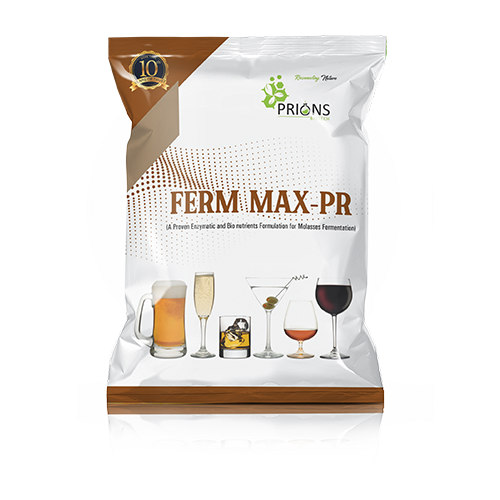Prions Biotech
Molasses Fermentation Enzyme (FERM MAX-PR)

Molasses Fermentation Enzyme (FERM MAX-PR)
(A Proven Enzymatic and Bio nutrients Formulation for Molasses Fermentation)This formulation contains Multi enzymes produced from Non-GMO sources.
FERM MAX-PR is a proprietary blend of enzymes & bio-nutrients. It is produced by solid-state fermentation. FERM MAX- PR that finds application in the manufacture of starch & Alcohol Industry.
MOLASSES FERMENTATION ENZYME MODE OF ACTION
Ferm Max- PR is a blend of all the above-mentioned enzymes and has three major modes of action.Hydrolyzes a part of unfermentable sugar in the molasses and converts it to reducing sugar. Which the yeast can take up for fermentation.
Protease side activity for Ferm Max- PR liberates FANN (Free Alpha Amino-Nitrogen) by hydrolyzing proteins present in molasses, which works as a food for yeast.
Protease hydrolyzes the cell wall of bacteria, which is made of proteins, thus leading to the elimination of contamination.
The critters responsible for the transformation of starch, cellulose, protease, Raffinose, Pectinase, etc. to sugar and then sugar to alcohol are called enzymes, chemically known as protein biocatalysts.
MOLASSES FERMENTATION ENZYME DOSAGE
Ferm Max- PR is dosed at 3-5ppm/MT of wash or wart or 10-15gm/MT of molasses. Divided doses have to be done at the pre-fermenter and fermentor stages to get the best results.Molasses Fermentation Enzyme Presentation
01Kg & 25Kg Carbo.Advantages of Molasses Fermentation Enzyme
- Ferm Max- PR can increase the yield of the final product by as much as 8-10 liters per ton of molasses.
- Ferm Max- PR reduces the volatile acid and contamination thus improving the quality.
- Ferm Max- PR causes a significant reduction in the effluent of spent wash more the alcohol increases
- Lesser the effluent output.
- Ferm Max- PR cases a tremendous reduction in fuel consumption per liter of alcohol.
Benefits of Molasses Fermentation Enzyme
- Increases in efficiency lead to a proportionate increase in CO2 collection.
- Elimination of lactobacillus contamination. Elimination of biocides antibiotics.
- Reduction in yeast invigorates.
- Reduction in antifoam agents.
- Reduction in scaling.
- Fermentation Efficiency increases by 2%-3%
- Reduction of RS
- Increases of alcohol 0.3% -0.5%
- Reduction of volatile acidity
